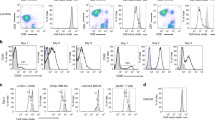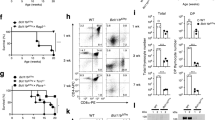Abstract
Studies of the murine immune response to infection with the intracellular bacterial pathogenListeria monocytogenes have provided a wealth of information about innate and acquired immune defenses in the setting of an infectious disease. Our studies have focused on the MHC class I restricted, CD8+ T cell responses of Balb/c mice toL. monocytogenes infection. Four peptides that derive from proteins thatL. monocytogenes secretes into the cytosol of infected cells are presented to cytotoxic T lymphocyte (CTL) by the H2-Kd major histocompatibility complex (MHC) class I molecule. We have found that bacterially secreted proteins are rapidly degraded in the host cell cytosol by proteasomes that utilize, at least in part, the N-end rule to determine the rate of degradation. The MHC class I antigen processing pathway is remarkably efficient at generating peptides that bind to MHC class I molecules. The magnitude of in vivo T cell responses, however, is influenced to only a small degree by the amount of antigen or the efficiency of antigen presentation. Measurements of in vivo T cell expansion followingL. monocytogenes infection indicate that differences in the sizes of peptide-specific T cell responses are more likely owing to differences in the repertoire of naive T cells than to differences in peptide presentation. This notion is supported by our additional finding that dominant T cell populations express a more diverse T cell receptor (TCR) repertoire than do subdominant T cell populations.
Similar content being viewed by others
References
Pamer EG: Immune response toListeria monocytogenes. Austin, R G Landes, 1997.
Gellin BG: Broome CV Listeriosis. JAMA 1989;261:1313–1320.
Mengaud J, Ohayon H, Gounon P, Mege RM, Cossart P: E-cadherin is the receptor for internalin, a surface protein required for entry of L monocytogenes into epithelial cells. Cell 1996;84:923–932.
Gaillard JL, Berche P, Frehel C, Gouin E, Cossart P: Entry ofL. monocytogenes into cells is mediated by internalin, a repeat protein reminiscent of surface antigens from Gram-positive cocci. Cell 1991;65:1127–1141.
Bielecki J, Youngman P, Connelly P, Portnoy DA:Bacillus subtilis expressing a haemolysin gene fromListeria monocytogenes can grow in mammalian cells. Nature 1990;345:175,176.
Tilney LG, Portnoy DA: Actin filaments and the growth, movement, and spread of the intracellular parasite,Listeria monocytogenes. J Cell Biol. 1989;109:1597–1608.
Domann E, Wehland J, Rohde M, Pistor S, Hartl M, et al.: A novel bacterial virulence gene inListeria monocytogenes required for host cell microfilament interaction with homology to the prolinerich region of vinculin. EMBO J 1992;11:1981–1990.
Kocks C, Gouin E, Tabouret M, Berche P, Ohayon H, Cossart P: L monocytogenes-induced actin assembly requires the actA gene product, a surface protein. Cell 1992;68:521–531.
Rogers HW, Callery MP, Deck B, Unanue ER:Listeria monocytogenes induces apoptosis of infected hepatocytes. J Immunol 1996; 156: 679–684.
Villanueva MS, Beckers CJM, Pamer EG: Infection withListeria monocytogenes impairs sialic acid addition to host cell glycoproteins. J Exp Med 1994;62: 1881–1888.
Mackaness GB: Cellular resistance to infection. J Exp Med 1962; 116:381–406.
Miki K, Mackaness GB: The passive transfer of acquired resistance toListeria monocytogenes. J Exp Med 1964;120:93–103.
Unanue ER: Studies in listeriosis show the strong symbiosis between the innate cellular system and the T-cell response. Immunol Rev 1997;158:11–25.
Unanue ER: Why listeriosis? A perspective on cellular immunity to infection. Immunol Rev 1997; 158:5–11.
Unanue E: Inter-relationship among macrophages, natural killer cells and neutrophils in early stages ofListeria resistance. Curr Opinion Immunol 1997;9:35–43.
Rogers HW, Unanue ER: Neutrophils are involved in acute, nonspecific resistance toListeria monocytogenes in mice. Infect Immun 1993;91:5090–5096.
Conlan JW, North RJ: Neutrophilmediated dissolution of infected host cells as a defense strategy against a facultative intracellular bacterium. J Exp Med 1991;174: 741–744.
Czuprynski CJ, Henson PM, Camp-bell PA: Enhanced accumulation of inflammatory neutrophils and macrophages mediated by transfer of T cells from mice immunized withListeria monocytogenes. J Immunol 1985;134:3449–3454.
Conlan JW, North RJ: Neutrophils are essential for early anti-Listeria defense in the liver, but not in the spleen or peritoneal cavity, as revealed by a granulocyte-depleting monoclonal antibody. J Exp Med 1994;179:259–268.
Dunn PL, North RJ: Early gamma interferon production by natural killer cells is important in defense against murineListeriosis. Infect Immun 1991;59:2892–2900.
Hiromatsu K, Yoshikai Y, Matsu-zaki G, Ohga S, Muramo K, Matsumo K, et al.: A protective role of γ/δ T cells in primary infection withListeria monocytogenes in mice. J Exp Med 1992; 175:49–56.
Bancroft GJ, Sheehan KC, Schrei-ber RD, Unanue ER: Tumor necrosis factor is involved in the T cell-independent pathway of macrophage activation in SCID mice. J Immunol 1989;143:127–130.
Kaufmann SHE, Hug E, DeLibero G:Listeria monocytogenes reactive T lymphocyte clones with cytolytic activity against infected target cells. J Exp Med 1986; 164:363–368.
Harty JT, Schreiber RD, Bevan MJ: CD8 T cells can protect against an intracellular bacterium in an interferon gamma-independent fashion. Proc Natl Acad Sci USA 1992;89: 11,612–11,616.
Harty JT, Bevan MJ: Specific immunity toListeria monocytogenes in the absence of INF gamma. Immunity 1995;3:109–118.
Ladel CH, Flesch IEF, Arnoldi J, Kaufmann SHE: Studies with MHC-deficient knock-out mice reveal impact of both MHC Iand MHC II-dependent T cell responses onListeria monocytogenes infection. J Immunol 1994; 153:3116–3122.
Pamer EG, Harty JT, Bevan MJ: Precise prediction of a dominant class I MHC-restricted epitope ofListeria monocytogenes. Nature 1991;353:852–855.
Pamer EG: Direct sequence identification and kinetic analysis of an MHC class I-restrictedListeria monocytogenes CTL epitope. J Immunol 1994; 152:686–694.
Wuenscher MD, Kohler S, Bubert A, Gerike U, Goebel W: Theiap gene ofListeria monocytogenes is essential for cell viability, and its gene product, p60, has bacteriolytic activity. J Bacteriol 1993; 175:3491–3501.
Gentschev I, Sokolovic Z, Kohler S, Krohne G, Hof H, Wagner J, et al.: Identification of p60 antibodies in human sera and presentation of this Listerial antigen on the surface of attenuated Salmonellae by the HlyB-HlyD secretion system. Infect Immun 1992;60:5091–5098.
Sijts AJAM, Neisig A, Neefjes J, Pamer EG: TwoListeria monocytogenes CTL epitopes are processed from the same antigen with different efficiencies. J Immunol 1996;156:685–692.
Harty JT, Pamer EG: CD8 T lymphocytes specific fo the secreted p60 antigen protect againstListeria monocytogenes infection. J Immunol 1995;154:4642–4650.
Busch DH, Bouwer AGA, Hinrichs D, Pamer EG: A nonamer peptide derived fromListeria monocytogenes metalloprotease is presented to cytolytic T lymphocytes. Infect Immun 1997;65:5326–5329.
Domann E, Leimeister-Wachter M, Goebel W, Chakraborty T: Molecular cloning, sequencing and identification of a metalloprotease gene fromListeria monocytogenes that is species specific and physically linked to the listeriolysin gene. Infect Immun 1991; 59:65–72.
Marquis H, Doshi V, Portnoy DA: The broad-range phospholipase C and a metalloprotease mediate listeriolysin O-independent escape ofListeria monocytogenes from a primary vacuole in human epithelial cells. Infect Immun 1995;63: 4531–4534.
Villanueva MS, Fischer P, Feen K, Pamer EG: Efficiency of antigen processing: a quantitative analysis. Immunity 1994;1:479–489.
Hess J, Gentschev I, Miko D, Welzel M, Ladel C, Goebel W, et al.: Superior efficacy of secreted over somatic antigen display in recombinant Salmonella vaccine induced protection against listeriosis. Proc Natl Acad Sci USA 1996;93:1458–1463.
Hess J, Dietrich G, Gentschev I, Miko D, Goebel W, Kaufmann SHE: Protection against murine listeriosis by an attenuated recombinant Salmonella typhimurium vaccine strain that secretes the naturally somatic antigen superoxide dismutase. Infect Immun 1997;65:1286–1292.
Shen H, Miller JF, Fan X, Kolwyck D, Ahmed R, Harty JT: Compartmentalization of bacterial antigens: differential effects on priming of CD8 T cells and protective immunity. Cell 1998;92:535–545.
Pamer EG: Cell mediated immunity: The role of bacterial protein secretion. Curr Biol 1998;8:457–460.
Sijts AJA, Pamer EG: Enhanced intracellular dissociation of major histocompatibility complex class I-associated peptides: a mechanism for optimizing the spectrum of cell surface-presented cytotoxic tT lymphocyte epitopes. J Exp Med 1997;185:1403–1411.
Levitsky V, Zhang QJ, Levitskaya J, Kurilla MG, Masucci MG: Natural variants of the immunodominant HLA A 11-restricted CTL epitope of the EBV nuclear antigen-4 are nonimmunogenic due to intracellular dissociation from MHC class I:peptide complexes. J Immunol 1997;159: 5383–5390.
Villanueva MS, Sijts AJAM, Pamer EG: Listeriolysin is processed efficiently into an MHC class I-associated epitope inListeria monocytogenes-infected cells. J Immunol 1995;155:5227–5233.
Hochstrasser M: Ubiquitin-dependent protein degradation. Annu Rev Genet 1997;30:405–439.
Ciechanover A: The ubiquitinproteasome proteolytic pathway. Cell 1994;79:13–21.
Sijts AJAM, Pilip I, Pamer EG: TheListeria monocytogenes p60 protein is an N-end rule substrate in the cytosol of infected cells: implications for MHC class I antigen processing of bacterial proteins. J Biol Chem 1997;272: 19,261–19,268.
Sijts AJAM, Villanueva MS, Pamer EG: CTL epitope generation is tightly linked to cellular proteolysis of aListeria monocytogenes antigen. J Immunol 1996; 156:1497–1503.
Miyahira Y, Murata K. Rodriguez D, Rodriguez J, Esteban M, Rodriguez M, et al.: Quantification of antigen specific CD8+ T cells using an ELISPOT assay. J Immunol Methods 1995; 181:45–54.
Vijh S, Pamer EG: Immunodominant and subdominant CTL responses toListeria monocytogenes infection. J Immunol 1997; 158:3366–3371.
Busch DH, Pamer EG: MHC class I/peptide stability: implications for immunodominance, in vitro proliferation and diversity of responding CTL J Immunol 1998; 160:4441–4448.
Vijh S, Pilip IM, Pamer EG: Effect of antigen processing efficiency on in vivo T cell response magnitudes. J Immunol 1998;160: 3971–3977.
Vijh S, Pilip IM, Pamer EG: Noncompetitive expansion of CTL specific for different antigens during bacterial infection. Infect Immun 1998;67:1303–1309.
Altman JD, Moss PAH, Goulder PJR, Barouch DH, McHeyzer- Williams, Bell JI, et al.: Phenotypic analysis of antigen specific T lymphocytes. Science 1996; 274:94–96.
Busch DH, Pilip IM, Vijh S, Pamer EG: Coordinate regulation of complex T cell populations responding to bacterial infection. Immunity 1998;8:353–362.
Busch DH, Pilip I, Pamer EG: Evolution of a complex T cell receptor repertoire during primary and recall bacterial infection. J Exp Med 1998;188:61–70.
Sourdive DJD, Murali-Krishna K, Altman JD, Zajac AJ, Whitmire JK, Pannetier C, et al.: Conserved T cell receptor repertoire in primary and memory CD8 T cell responses to acute viral infection. J Exp Med 1998;188:71–82.
Callan MFC, Annels N, Steven N, Tan L, Wilson J, McMichael AJ, et al.: T cell selection during the evolution of CD8+ T cell memory in vivo. Eur. J Immunol 1998; 28:4382–4390.
Busch DH, Pamer EG: T cell affinity maturation by selective expansion following infection. J Exp Med 1999;189:701–709.
Kaufmann SHE, Rodewald HR, Hug E, Libero GD: ClonedListeria monocytogenes specific non-MHC-restricted Lyt-2+ T cells with cytolytic and protective activity. J Immunol 1988;140: 3173–3179.
Lukacs K, Kurlander RJ: MHC-unrestricted transfer of antilisterial immunity by freshly isolated immune CD8 spleen cells. J Immunol 1989;143:3731–3736.
Kurlander RJ, Shawar SM, Brown ML, Rich RR: Specialized role for a murine class I-b MHC molecule in prokaryotic host defenses. Science 1992;257:678–679.
Pamer EG, Wang CR, Flaherty L, Lindahl KF, Bevan MJ: H2-M3 presents aListeria monocytogenes peptide to cytotoxic T lymphocytes. Cell 1992;70:215–223.
Shawar SM, Cook RG, Rodgers JR, Rich RR: Specialized functions of MHC class I molecules. I An N-formyl peptide receptor is required for construction of the class I antigen Mta. J Exp Med 1990;171:897–912.
Loveland BE, Wang CR, Yone-kawa H, Hermel E, Lindahl KF: Maternally transmitted histocompatibility antigen of mice: a hydrophobic peptide of a mitochondrially encoded protein. Cell 1990;60: 971–980.
Gulden PH, Fischer P, Sherman NE, Wang W, Engelhard V, Shabano-witz J, et al.: AListeria monocytogenes pentapeptide is presented to cytolytic T lymphocytes by the H2-M3 MHC class Ib molecule. Immunity 1996;5:73–79.
Lenz LL, Dere B, Bevan MJ: Identification of an H2-M3-restricted Listeria epitope: Implications for antigen presentation by M3. Immunity 1996;5:63–72.
Princiotta MF, Lenz LL, Bevan MJ, Staerz UD: H2-M3 restricted presentation of a Listeria-derived leader peptide. J Exp Med 1998; 187:1711–1720.
Author information
Authors and Affiliations
Rights and permissions
About this article
Cite this article
Finelli, A., Kerksiek, K.M., Allen, S.E. et al. MHC class I restricted T cell responses tolisteria monocytogenes, an intracellular bacterial pathogen. Immunol Res 19, 211–223 (1999). https://doi.org/10.1007/BF02786489
Issue Date:
DOI: https://doi.org/10.1007/BF02786489




